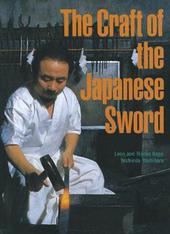
|
The Craft Of The Japanese Sword
Hardback
Main Details
| Title |
The Craft Of The Japanese Sword
|
| Authors and Contributors |
By (author) Leon Kapp
|
|
By (author) Hiroko Kapp
|
| Physical Properties |
| Format:Hardback | | Pages:168 | | Dimensions(mm): Height 265,Width 192 |
|
| Category/Genre | The arts - general issues |
|---|
| ISBN/Barcode |
9781568364315
|
| Classifications | Dewey:623.441 |
|---|
| Audience | |
|---|
| Edition |
2nd Revised edition
|
| Illustrations |
1 Illustrations, unspecified
|
|
Publishing Details |
| Publisher |
Kodansha America, Inc
|
| Imprint |
Kodansha America, Inc
|
| Publication Date |
7 September 2012 |
| Publication Country |
United States
|
Description
Well over a thousand years old, the tradition of swordmaking in Japan is one of the most highly regarded metal crafts in the world. When all sword manufacture was prohibited in Japan for seven years after World War II, the age-old techniques were in danger of being lost forever. Today, in the hands of a new generation of practitioners, the craft is making a startling comeback. Connoisseurs say that the swords being produced now are the equal of anything made in Japan in the past few hundred years. This book takes the reader into the workshops of four of Japan's leading sword craftsmen. Each craftsman has a different role in the manufacture of a blade. Yoshindo Yoshihara, the swordsmith, begins with raw steel made in a traditional charcoal-fueled smelter and refines it by folding and forging, gradually shaping it into a sword with a hardened edge. Okisato Fujishiro then sharpens and polishes the sword with fine stones to reveal the color and texture of the steel. Metalworker Hiroshi Miyajima makes the small copper-and-gold habaki collar that fits between the blade and the scabbard. Finally, Kazuyuki Takayama carves the hilt and the scabbard out of a single piece of wood. Black-and-white photographs show every stage of the manufacture, while important information on history, metallurgy, and modern-day appraisal is presented in an extensive introduction. The swords made in Japan today are not, of course, intended for actual use. But their design, the quality of their steel, and the techniques used to create them still derive from the sword's historical function as a lethal hand-held weapon. A sword must be razor sharp, light, well balanced, and strong, but not so brittle it will break. In the perfect resolution of these qualities lie the beauty of the blade and the challenge of the craft. This book demonstrates how brilliantly Japan's sword craftsmen today have met this technological challenge. The impulse of the craft now is to preserve the utilitarian object and yet create an enduring art for the modern age. While many fine books on sword appreciation exist, these deal primarily with older blades or problems of appraisal. The Craft of the Japanese Sword is the first book in English devoted entirely to contemporary sword manufacture, and will thus be of enormous value to metal artists everywhere, as well as to collectors and students of weaponry.
Author Biography
LEON KAPP is a molecular biologist at the University of California in San Francisco. He has studied swordmaking in Japan at the forge of the swordsmith Yoshindo Yoshihara. HIROKO KAPP was active as a graphic artist in Tokyo for ten years and is now a correspondent for the Tokyo-based Senken news organization. The Kapps live in San Rafael, California. YOSHINDO YOSHIHARA is a tenth-generation swordsmith who is ranked among the top sword craftsmen in Japan today. He began forging blades at the age of twelve and has exhibited several times in the United States. His son is currently working with him and will become the eleventh generation of the family to carry on the tradition.
|